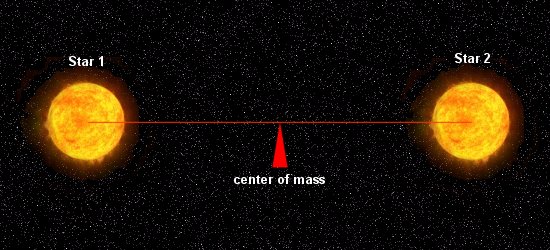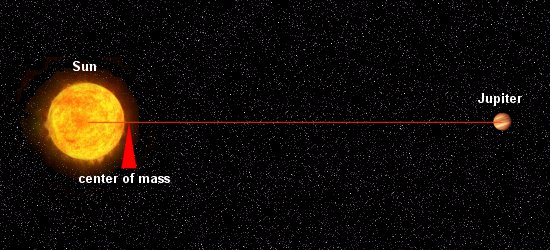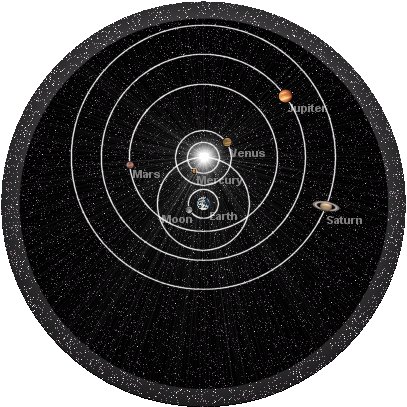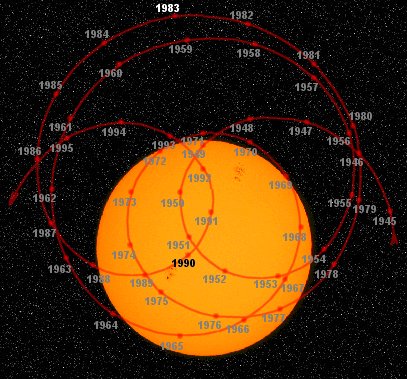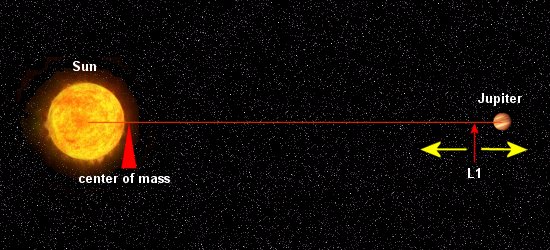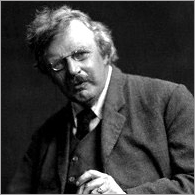Is it physically possible for the whole universe to orbit the earth?
by Gary Hoge
Normally, as you know, light celestial bodies orbit heavy celestial bodies. That’s why the relatively light planets orbit the extremely heavy sun. But according to geocentrists, the extremely heavy sun, the planets, and even the stars and galaxies, all orbit the comparatively-miniscule earth. As Ken Cole has eloquently pointed out, this is a contradiction of Newton’s second law of motion, and his law of universal gravitation. Or is it?
The geocentrists claim that it is possible for everything in the universe to orbit the earth each day, without violating Newton’s laws. They say this happens because the universe rotates around its center of mass, and the earth just happens (by God’s design) to sit right at that very spot. Robert Sungenis, president of Catholic Apologetics International, says:
From a geocentric point of view, the earth was created first and was the Center of Mass (Genesis 1:1-2). The other celestial objects were subsequently created (Genesis 1:14-17) and were placed around the earth with the earth still being the Center of Mass. God, as it were, calculated all the forces in the starry universe, and balanced them so that earth could be the center of mass. And then God set everything in motion, and it has remained so, just as Newton’s laws of inertia state.1
Is this possible? Well, let’s see. First, you may be wondering what a “center of mass” is. The “center of mass,” also known as the “center of gravity,” is simply the center of all the material that makes up an object, or a group of objects. It’s the point at which an object will balance. A tennis racquet, for example, will usually balance at a point on its shaft near the head. This is the racquet’s center of mass. If you get mad and throw the racquet, it will rotate around its center of mass before it smashes into the ground.
A group of celestial objects, such as a star system, also has a center of mass. It is the “balance point” of all the objects in that system. A simple example is a binary star system, such as the one shown below.
If the two stars in this system are equally massive, the center of mass will be exactly halfway between them. This is easy to understand if you imagine building a model of this system using two softballs held together by a metal rod. It should be intuitively obvious that if you tried to balance such a model on your finger, it would balance at the halfway point between the two softballs.
But what if the two masses aren’t equal? In that case, the center of mass would be skewed toward the heavier object. In our solar system, for example, the two primary masses are the sun and Jupiter, as shown below.
The sun is over a thousand times more massive than Jupiter, and that skews the center of mass toward the sun, to a point just outside its surface. Again, this is easy to visualize if you imagine building a model in which a bowling ball (representing the sun) is attached to a golf ball (representing Jupiter) with a rod. Obviously, the balance point of that model would be very near the bowling ball.
Just like the tennis racquet that spins around its center of mass when thrown, every celestial system also orbits its center of mass. If our solar system consisted of just the sun and Jupiter, the point shown in the figure above would be the permanent center of mass of the solar system, and both the sun and Jupiter would orbit that point forever.2
Now, let’s factor into the equation all the other planets, the stars, the galaxies, and every other object in the universe. Where would the center of mass of the entire universe be? Is it possible for the earth to be at the center of mass, as the geocentrists claim? Most of us would say that the earth isn’t the center of anything. It’s just a small planet that orbits a small star on the outskirts of a galaxy that isn’t the center of anything, either. But the geocentrists say that the universe is really very different than we think it is.
The figure on the left illustrates the geocentric universe as conceived by the great astronomer Tycho Brahe. Brahe, of course, knew of only the six visible planets, so the modern version of this model would have to be expanded to include the outer planets.
According to this model, all the planets except the earth orbit the sun, and the sun and moon orbit the earth. The stars, which are much smaller and closer than we imagine, form a spherical “shell” around the earth, as shown in the figure. Note that this figure is not to scale; modern geocentrists agree that the nearest star is about 4 light years away. However, they say that the farthest star probably isn’t more than 300 light years away.
If the geocentrists are right about the nature of the universe, would it be possible for the earth to be at the center of mass of such a system? The answer is, yes! To make this happen, it would only be necessary to have some other mass balance the mass of the nearby sun and thereby skew the center of mass of the whole system out to where the earth is located.
To understand how this could work, pretend for a moment that the solar system consisted of just the earth and the sun. If that were the case, the center of mass of that system would be right about at the center of the sun, as shown below, because the earth has almost no mass compared to the sun.
But suppose we put a relatively heavy planet near the earth. As shown in the figure below, its mass would skew the center of mass of the system away from the sun.
If we kept moving that planet farther and farther away, the center of mass of the system would eventually coincide with the earth, as shown below.
Now, remember that the nearest star is a whopping four light years away. At that distance, a small planet just 25% more massive than the earth would be sufficient to skew the center of mass of the whole system away from the sun and out to the earth. Therefore, if the mass distribution of the stars is just slightly lopsided in the direction opposite that of the sun, it would be possible that the center of mass would fall at the center of the earth, assuming, of course, that our solar system is at the center of the universe, as the geocentrists claim.
So far, so good. But here’s where the geocentrists make a crucial error. Even if they were right about our solar system being at the center of the universe, they fail to take into account the fact that the universe is in a constant state of motion. The planets all move relative to the sun, and relative to each other, and over the course of a year, the sun moves all the way around the sky, relative to the stars. As all of these masses move relative to each other, obviously their combined center of mass is going to move too.
For example, I noted above that if Jupiter were the only planet in the solar system, both it and the sun would orbit a fixed point in space forever. But Jupiter isn’t the only planet in the solar system. As the other heavy planets move to different positions around the sun, they cause the center of mass of the solar system to shift.
Figure 7: The solar system’s center of mass: 1945 – 1995
The figure on the left shows the location of the solar system’s center of mass for each year between 1945 and 1995. As you can see, over a fifty-year period, the complex motion of the heavy outer planets, especially Jupiter, profoundly affects the location of the solar system’s center of mass. In 1983, for example, the center of mass was located a considerable distance from the center of the sun. That’s because in that year, all of the outer planets – Jupiter, Saturn, Uranus and Neptune – were on the same side of the sun, putting almost all of the solar system’s planetary weight on one side of the sun, and thus skewing the center of mass away from the sun. But in 1990, the center of mass of the solar system almost coincided with the center of the sun. That’s because in that year, Jupiter, which is heavier than all the other planets combined, was on the opposite side of the sun from Saturn, Uranus and Neptune. Thus, these large planets tended to balance each other out, and leave the center of mass near the center of the sun.
The point of all this is to illustrate the fact that the center of mass of a moving system will always be moving, too. So, if the earth ever were at the center of mass of the universe, even a geocentric universe, it wouldn’t be there for long. Also, recall that in order to compensate for the mass of the nearby sun and skew the center of mass out to the location of the earth, it was necessary to assume that the “shell” of stars was slightly heavier in the direction opposite that of the sun. But the sun is constantly moving relative to the stars, completing a full circuit of the sky over the course of a year. So even if the stars were heavier in a given direction, the sun would only be located opposite that direction at one time during the year. Six months later, the sun would be located in the same direction from the earth as the heavier side of the shell of stars, and that would skew the center of mass back toward the sun.
An even more devastating error the geocentrists make is that they assume that the center of mass of a celestial system is also going to be the point at which the gravitational forces from the various masses in the system all cancel out, so that if a planet were located at such a point it would sit there calmly, like a boat in the eye of a hurricane. Indeed, their whole argument depends upon this assumption.
But they are mistaken.
This is easily seen by referring to the figure below, which again shows the center of mass between the sun and Jupiter. The figure also shows the point at which the gravitational forces from the sun and Jupiter cancel each other out. There is a name for this point: it’s called Lagrange point 1, or L1. It’s the point between two celestial bodies at which the gravitational forces cancel out, and at which an object of negligible mass could theoretically remain stationary for a long period of time without needing any propulsion.3
As you can see, the center of mass is nowhere near the point of gravitational equilibrium (L1). In fact, these are two completely different concepts. The center of mass is the point in space that both the sun and Jupiter orbit, but it is not a point of gravitational equilibrium. Far from it. In fact, that point is so close to the sun that if there were a planet the size of the earth located there, the gravitational pull from the sun would be over a billion times stronger than the gravitational pull from Jupiter. That planet wouldn’t just sit there, it would plunge into the sun. Rapidly.
Why is this so? It’s because gravitational force is directly proportional to mass. In other words, all other things being equal, a massive body, like the sun, is going to exert a far greater gravitational attraction than a lesser mass, like Jupiter. Right away, that tells us that the point where the sun’s gravitational pull equals that of Jupiter is going to be much closer to Jupiter than to the sun. In fact, the point of equilibrium is only about 32 million miles from Jupiter. The center of mass, on the other hand, is about 483 million miles from Jupiter.
This fact completely undermines the geocentrist argument, because even if it were possible for the earth to be permanently at the center of mass of the universe, that point is not a point of gravitational equilibrium. It can’t be. The nearby sun is so massive (it accounts for 99.86% of the mass of the solar system) that it exerts a huge gravitational pull on the earth. The only way the earth could remain stationary is if there were some other object out there in space massive enough to counteract that pull, but there’s simply nothing in the whole universe that can exert enough force to rival the gravitational pull from the sun.
It’s not just that the sun is so massive – there are, after all, many objects in the universe more massive than the sun – it’s that the sun is both massive and close. Distance is crucial because gravitational attraction is inversely proportional to the square of the distance between two objects. That’s just a fancy way of saying that as you move away from a mass, its gravitational attraction decreases exponentially. Therefore, the amount of mass it would take to counteract the gravitational pull from the sun increases exponentially as you move away from the earth. By the time you get out to the edge of the solar system, it would take over 1,500 suns to do it! By the time you get to the nearest star, over four light years away, it would take more than 17 billion suns to do it. Clearly, then, there will always be a strong net pull on the earth in the direction of the sun. Therefore, the earth must either orbit the sun, or fall into it.
The bottom line is that if the geocentrists are right about the structure of the universe, it would be possible for the center of mass to be located as far away from the sun as the earth is. And yes, everything would orbit that point. But it would be impossible for a planet, or any other object, to remain motionless at that point, for two reasons. First, the center of mass itself is constantly shifting as the various masses in the universe rearrange themselves, and second, a point in space that close to the sun would not be a point of gravitational equilibrium. There would be an overwhelming gravitational pull from the sun. A planet at that location would either have to move fast enough to orbit the sun (as the earth, in fact, does), or it would plunge into the sun and be destroyed. In no case could it simply sit there motionless.
End Notes
1 Sungenis, Robert A. “Posting #53 – Center of Mass.” CAI Website. Retrieved 7 July 2004 <http://www.catholicintl.com/epologetics/geo53.asp>
2 If you could observe the sun from a great distance, say from another star system, it would appear to wobble as it orbited the solar system’s center of mass. That’s how astronomers search for planets around other stars. They look for stars that “wobble,” because they know that such wobbling must be caused by the presence of large planets skewing the center of mass of that star system away from the geographic center of the star.
3 The L1 point between the earth and the sun is about 932,000 miles from the earth. An object placed at that point should remain stationary, and NASA has taken advantage of that fact and parked a spacecraft, called the Solar and Heliospheric Observatory (SOHO), there. Unfortunately, the L1 point is a point of unstable equilibrium. Any object placed there will eventually drift away, so SOHO has to fire its thrusters from time to time to maintain its position. This is another strike against the geocentrist position, because even if the earth were at the center of mass of the universe, and even if the gravitational forces of the universe cancelled out at that point, it would be an unstable equilibrium, and the earth would eventually drift away from the center.

